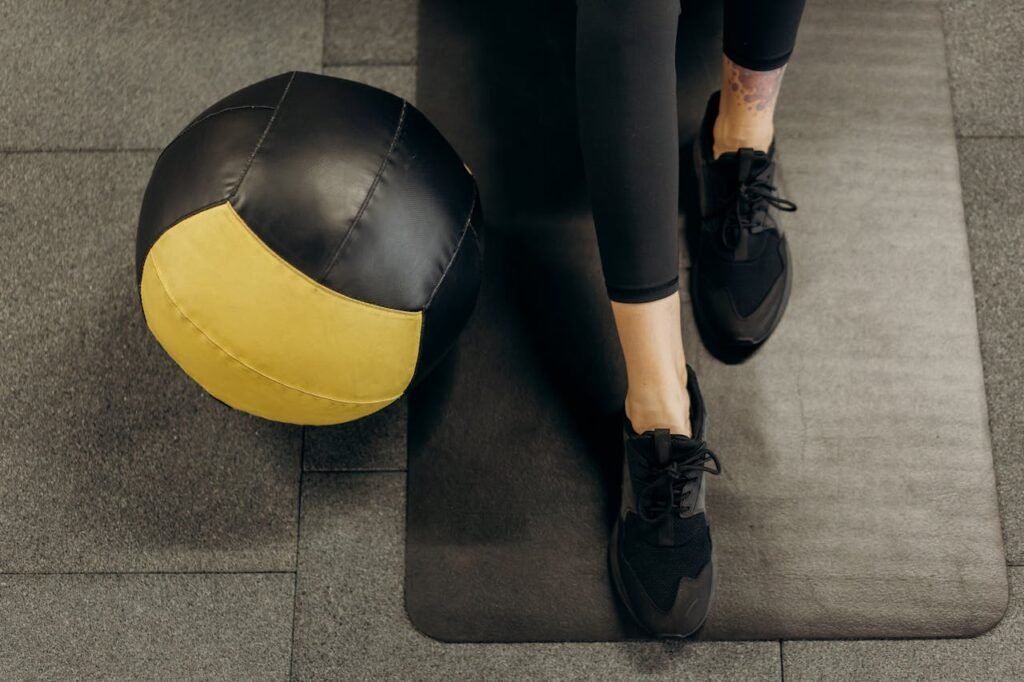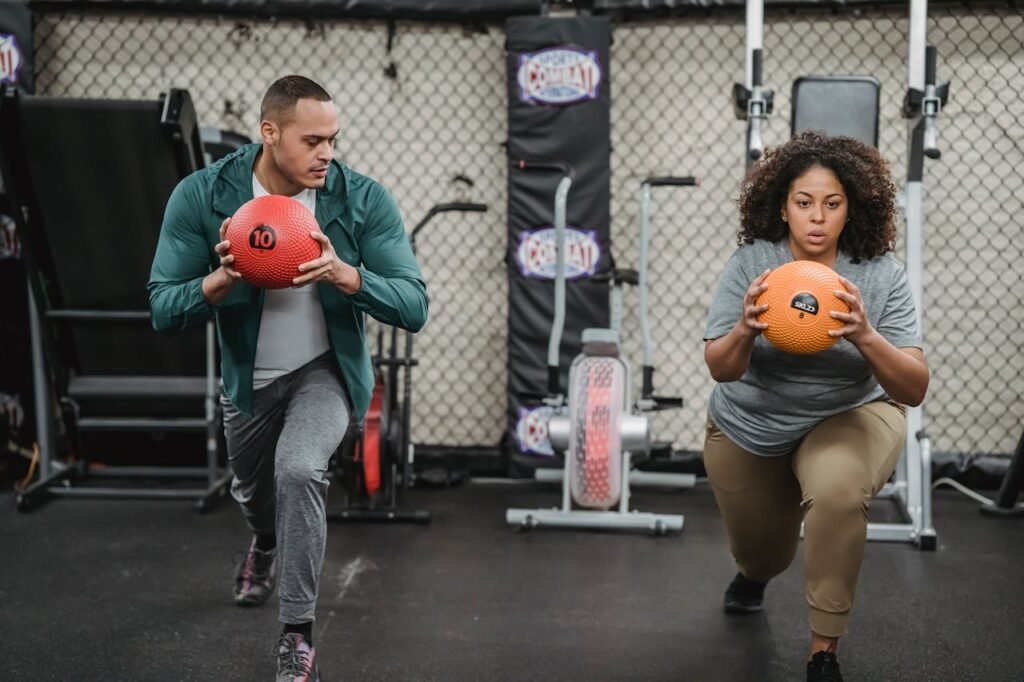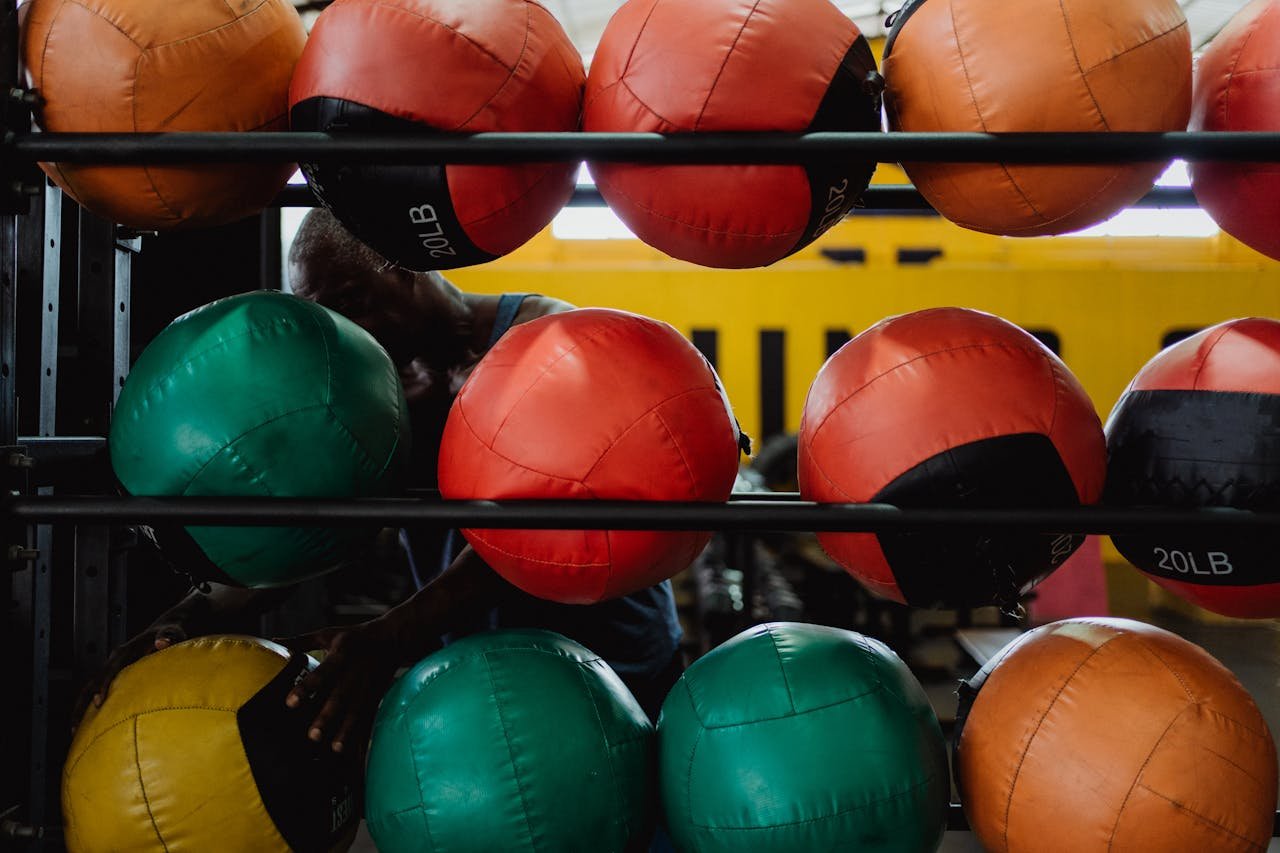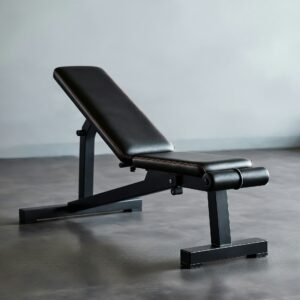If you’re building a home gym or looking to level up your workouts, medicine balls are one of the most underrated and versatile pieces of equipment out there. Whether you’re a beginner or a seasoned athlete, weighted balls can help you build strength, improve balance, and develop explosive power—all in a compact, portable package.
In this guide, we’ll cover the types of medicine balls, their benefits, beginner tips, and the best exercises to get started.
Disclosure: We may earn a commission from links mentioned in this post, at no extra cost to you. We only recommend products we genuinely trust
Table of Contents

What Is a Medicine Ball?
A medicine ball is a weighted ball that can range from 2 to over 70 pounds and comes in various textures, fillings, and sizes. Think of it as a heavy basketball—but with many more uses.
Some are filled with air and bounce (like rubber medicine balls), while others—like slam balls—don’t bounce at all. You’ll also find wall balls (larger and softer, ideal for throwing at walls) and soft weighted balls, often used in rehab or light resistance training.
Key Benefits of weighted Balls
1. Improves Core Strength and Stability
Many weighted ball exercises engage your entire core, including the abdominals, obliques, and lower back. Moves like Russian twists, woodchoppers, and overhead slams challenge core control and improve posture, which can translate into better performance during sports or everyday tasks.
2. Builds Explosive Power
Unlike static dumbbells, medicine balls allow for dynamic, full-body movements. Exercises such as weighted ball slams and chest passes train you to generate force quickly, improving your athletic performance. This kind of training is often referred to as plyometric or power-based training.
3. Enhances Coordination and Balance
Because you’re often moving the ball in multiple directions and planes (e.g., twisting, throwing, catching), your brain and body have to coordinate in real time. This boosts proprioception (your body’s sense of position) and reinforces better movement patterns.
4. Increases Functional Strength
Weighted ball workouts mimic real-life motions, like picking something up off the ground or twisting to put something on a shelf. These compound movements train multiple muscle groups at once, helping you build strength that carries over into everyday life.
5. Adds Variety and Prevents Plateaus
Stuck doing the same squats and push-ups? Weighted balls let you add new angles, resistance, and intensity, helping you break through plateaus. Plus, they make training more fun and engaging.
Types of Weighted Balls
Traditional weighted Balls
Usually made of rubber or vinyl, these are your standard weighted balls that can bounce and be used for general strength training.
Best for: Core exercises, balance training, general strength work.
Slam Balls (Non-Rebounding)
Heavier and filled with sand or gel, slam balls don’t bounce—making them perfect for powerful slams without risking a rebound to the face.
Best for: Overhead slams, conditioning drills, explosive movements.
Wall Balls
Larger and softer, wall balls are ideal for high-rep throwing exercises, especially against walls or targets.
Best for: Wall squats, full-body throws, CrossFit-style workouts.
Soft Weighted Balls
Typically lighter and more flexible, these are ideal for rehabilitation or low-impact routines. They’re filled with gel or sand and often have a textured grip.
Best for: Rehab, light resistance training, partner exercises.
How to Choose the Right Weighted Ball
Start with your fitness level and goals. Most men can begin with a 10–15 lb ball, while women may start with 6–10 lbs. If your focus is speed and control, go lighter. If it’s power and strength, go heavier—but not so heavy that it compromises your form.
Also consider where you’ll be training. If you’re working out at home, non-rebounding slam balls are safest. If you’re training with a partner or using a wall, traditional or wall balls make sense.

Popular Weighted Ball Exercises
Here are a few go-to exercises that blend strength, power, and coordination:
1. Weighted Ball Slams
- Targets: Core, shoulders, arms, legs
- How: Raise the ball overhead, then slam it to the ground with force. Repeat for 10–15 reps.
2. Russian Twists
- Targets: Obliques, core
- How: Sit on the ground with knees bent, twist from side to side while holding the medicine ball.
3. Squat to Overhead Press
- Targets: Legs, glutes, shoulders
- How: Perform a squat while holding the ball, then press it overhead as you stand up.
4. Lunge with Twist
- Targets: Legs, glutes, core
- How: Lunge forward and twist your torso toward the leading leg with the ball extended in front of you.
5. Chest Pass (Partner or Wall)
- Targets: Chest, shoulders, triceps
- How: Stand facing a partner or wall and push the ball from your chest with both hands.
How Beginners Can Get Started
Start Light
Begin with a manageable weight so you can focus on proper form. A lighter ball allows you to move with control and reduces injury risk.
Focus on Form
Don’t rush through exercises. Quality reps over quantity—especially with dynamic movements like slams and throws.
Use Them in Circuits
Medicine balls work great in HIIT-style circuits. Try mixing them with bodyweight moves like push-ups, squats, or sprints for a full-body burn.
For more effective cardio options to complement medicine ball training, consider incorporating jump rope workouts, which boost endurance and coordination.
Warm Up and Cool Down
Use light movements with the medicine ball to warm up your joints and core before jumping into high-intensity work. Cool down with slower, controlled moves like twists and stretches.
Pros & Cons of weighted Balls
Pros
- Inexpensive and space-saving
- Improve explosive power and core strength
- Easy to use for partner workouts
- Great for home gyms or outdoor training
- Functional, full-body movement patterns
Cons
- Can cause injury if form is poor or weight is too heavy
- Slam balls may damage floors if not used on a proper surface
- Bouncing balls may rebound unpredictably
Alternatives to Weighted Balls
If you don’t have a Weighted ball, try these:
- Kettlebells – Great for dynamic swings and lifts
- Sandbags – Offer similar instability and weight variety
- Dumbbells – Good for static strength but less functional movement
- Resistance bands – Useful for controlled core or rehab exercises
Final Thoughts: Is a weighted Ball Worth It?
Absolutely. Whether you’re working out in a cramped apartment or setting up a full garage gym, Weighted balls are versatile, effective, and affordable. They offer a powerful way to train explosively, build core strength, and keep your workouts fresh.
If you’re looking for an all-in-one training tool that enhances strength, coordination, and athleticism, Weighted balls are a smart investment.






Pingback: Balance Ball: 5 Powerful Benefits for Home Fitness
Pingback: 4 Best Ab Workout Equipment for Home Fitness